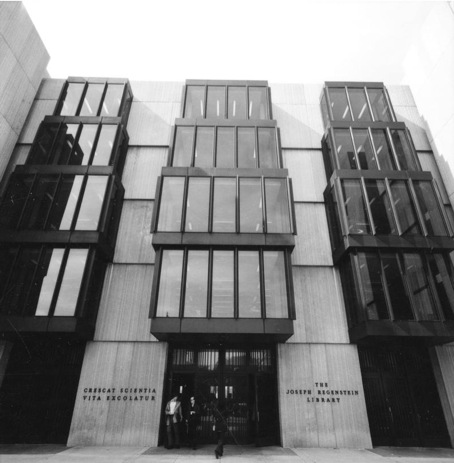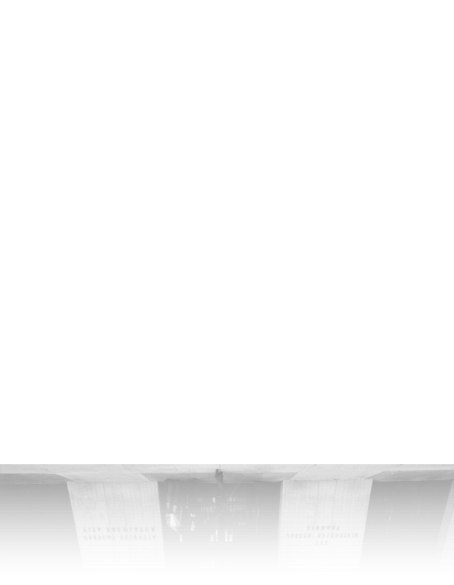The University of Chicago Libraries and the Public



by Benjamin J. Dueholm
I. Introduction
Two small cracks appeared in the fortresslike Regenstein Library in 2005. The University libraries approved a pilot program granting neighborhood public schoolteachers access to the Regenstein. And in early April, the Regenstein turnstiles malfunctioned, compromising the security of the library. While strictly coincidental, the two developments offer a fortuitous glimpse into the history of the complicated relationship between the libraries and the public.
The teacher access program, proposed by Dean of Humanities Danielle Allen, is designed to build trust and exchange of knowledge between the University and the wider community by sharing resources. While the program was intended to be a novel rethinking of the University’s place in the South Side, it in fact hearkens back to the early years of the University, when members of the public had much greater access to the shelves, collections of University-owned books traveled to towns all over the country, and schoolteachers had borrowing privileges at the School of Education.
The turnstiles, on the other hand, are the product of a more recent phase in the library’s history, when concerns about cost, book loss, and safety had led to an almost total separation of the library’s sources from the local community. The teacher access program and other actual and possible library outreach programs show how a changed understanding of the University’s role in the community and new technological capacities can make the library a public resource without jeopardizing its academic functions.
II. Early History of Access
In the early decades of the University’s existence, the community had access to the library’s resources in three ways: in the buildings themselves, through ‘traveling libraries’ associated with Extension courses, and through access to the School of Education library to public school teachers. From the very beginning, the University libraries were open to the public for reference use. By 1916, the access policy allowed “members of other educational institutions in the vicinity, and residents of Chicago engaged in serious study” to use the reading rooms. Full privileges were available for a fee. Moreover, starting in 1894, the General Library (a temporary structure eventually replaced by Harper Memorial) housed a delivery station of the Chicago Public Library. This allowed students to borrow “popular” books through the city system while the University concentrated its spending on scholarly and reference volumes. The station issued hundreds of library cards each year and delivered as many as 7,714 volumes (in 1901). It was no less a resource and a point of contact for local residents.
The openness of the libraries was significant. A local bank touted the public access to the libraries while promoting Woodlawn as a summer residence. However, the University’s holdings had an exponentially larger effect beyond the campus through the Division of Extension. Through this division, University lecturers traveled throughout the city, region, and eventually the whole country teaching courses on history, literature, sociology, and other subjects. The courses were intended to provide University-level work for University credit, and so required accompanying texts for home study by students. They took place in churches, libraries, schools, and other public venues. The books in the libraries were available for loan as long as the course was offered, at which point they could be purchased at varying degrees of discount.
The traveling libraries and the extension courses they accompanied made a varied but often very significant impact on the educational environment of the small towns and cities to which they were sent. While many “lecture centres” reported difficulty in developing interest, maintaining participation, and sustaining funding, there were many others that reported excitement and enthusiasm. A correspondent in Tremont, Illinois reported “the great amount of reading done…each book being examined by several readers during the twelve weeks of the course.” Shop clerks and sympathetic customers in Chicago’s Englewood neighborhood advocated for earlier closing times to enable clerks to take the courses. There are reports of calls for more books than were originally available, high school students participating avidly, and of newspapers publishing encouragement to active study. The Extension Movement, as its participants and advocates called it, gave broader access to higher education when it was still enjoyed by relatively few. It also played a significant role in building public interest in and basic collections for municipal library systems.
During the first decade of the 20th century, the University dispatched as many as 106 libraries containing 6,291 volumes in a year for courses in up to thirteen states. They helped make available many books that were considered either too narrow in interest or too expensive for public libraries to purchase. An internal document calls the traveling libraries “one of the greatest agencies for good” undertaken by the University.
In 1909, newly appointed School of Education Dean Charles H. Judd requested a policy change allowing local teachers to have full privileges in the School’s library. The next year, this policy was implemented, subject to the needs of the library and the endorsement of the teachers’ principals. The archival material on this policy is sparse, however, and the arguments for and against it appear to be lost, as well as any indication of how much use teachers made of the access.
The attitude of founding President William Raney Harper towards higher education, and University Extension in particular, is evident in these three points of contact between the libraries and the wider public. For Harper, the goal of a true university was “[s]ervice for mankind wherever mankind is, whether within scholastic walls or without those walls and in the world at large.” This manifested itself in a commitment to making education as widely available as possible, despite social, economic, or geographic barriers. This zeal for extending education was not unique to the University of Chicago. Many universities had been experimenting with extension courses, workers’ education, and other initiatives since the 1870’s. The University of Chicago, however, was founded with a central place for such a missionary program. Harper had significant previous experience in extension education and deliberately made the Division one of only five when the University was founded. Harper’s democratic principles, while undoubtedly sincere, were not merely altruistic. He understood that a vigorous education outreach would give the University a more congenial cultural environment and would increase its power and scope.
III. The Decline of Public Access
Each of these programs, notwithstanding Harper’s evangelical enthusiasm, eventually experienced problems of cost and even safety. By the early years of the 20th century, the Board of Libraries was trying to change the public library station, either requiring the station to hire an attendant, to move to a different location while remaining in cooperation, or to close entirely. The Director of Libraries had been asked to report on the number of “outside readers,” but if any such survey was done, it has apparently been lost. The traveling libraries, along with the lecture courses they supported, did not become financially self-sufficient as the Extension Division had planned. After the 1911-12 school year, when the courses were discontinued, the deficit was over $6,300—almost what it had been the division was founded.
On campus, there were concerns about increasing book theft and loss. Archival references to these problems are as old as the library, but there was a perception of increased incidence in the 1920’s. Non-University users were under explicit suspicion by 1929 (Presidents’ Papers, 1925-45, 51:4). Access to borrowing privileges, even for a fee, was strictly curtailed in 1932 (correspondence, 10/12/40). In the 1960’s, the archives show an increasing concern with crime and safety in the buildings, from memos about book theft to a note that a certain supervisor would not work on evenings or weekends without better security (correspondence, 8/29/69; 9/30/68). It is not known when access became restricted to University community members and visiting scholars, but it is likely that by the time the Regenstein opened, the general public-spiritedness that characterized the early library had become a thing of the past.
IV. The Future of Public Access
The openness of the University Library’s early years fell into decline for fairly simple reasons. Circulating books and library facilities are what economists call “rival goods.” As every student learns at some point, one person’s use of a book prohibits someone else’s. In this way, each additional person who has borrowing privileges slightly reduces everyone else’s access to books. This is especially true if there is significant non-University borrowing while acquisitions are tied to enrollment. Moreover, there are ways to police the book use of students, whose delinquent charges can be added to tuition or used to block various privileges. Such levers do not apply to visitors to campus. This fact is acknowledged by the steep borrowing fees assessed to alumni, who can access the buildings without charge.
In the case of the traveling libraries, it had been envisioned that the local lecture centers would gradually take on the full costs of the program after some initial years of subsidy. The costs, however, proved too high to be borne by the centers. The Extension Division never stopped subsidizing the courses and the ongoing and indefinite costs became more than the University wished to carry. Extension education lives on in the Graham School of General Studies, but without any library component. It is a valuable but relatively modest heir to Harper’s grand democratic ambitions.
However, public access to the library’s resources has, in recent years, began a renaissance of sorts. Internet technology has allowed the University libraries to work with the Chicago Public Schools to give access to “non-rival” goods such as online reference resources. The eCUIP program offers content on math, science, fine arts, African-American studies, local history, and other areas, available for free online. The eCUIP site also hosts a “web docent” program, in which teachers can access online materials from Chicago’s major museums.
The teacher-access program follows this pattern of addressing library resources to educators. The pilot will include up to five teachers from each Washington Park-area school. It does not include borrowing privileges, but will give these educators access to the important research materials available in the Regenstein and through the University’s online portals. In this way, students and teachers will have minimal competition for the library’s holdings.
Library outreach in all its forms—open shelves, traveling libraries, and teacher access—was an integral part of a University that saw itself as public-minded and outwardly focused. New technologies and new resolve are helping the library, and with it the University as a whole, begin recovering the fullness of its role “within these scholastic walls or without.
uchicago®  ©2007 The University of Chicago®
©2007 The University of Chicago®  5801 South Ellis Ave., Chicago, IL 60637
5801 South Ellis Ave., Chicago, IL 60637  773-702-1234
773-702-1234
 ©2007 The University of Chicago®
©2007 The University of Chicago®  5801 South Ellis Ave., Chicago, IL 60637
5801 South Ellis Ave., Chicago, IL 60637  773-702-1234
773-702-1234 Image sources
Joseph Regenstein Library: Archival Photofiles, apf2-06176, Special Collections Research Center, University of Chicago Library.